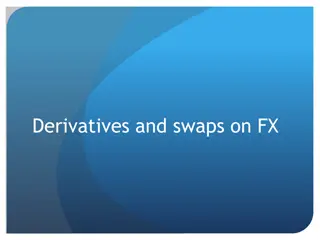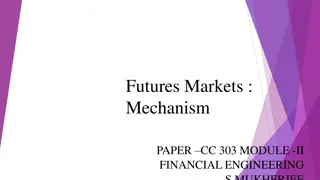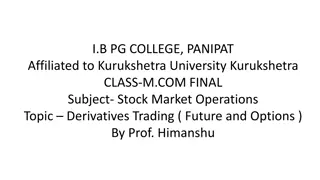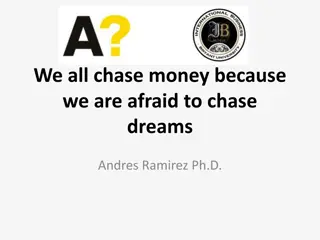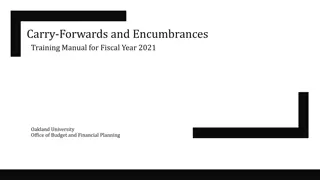
Price vs Value in Financial Markets
Explore the concepts of price vs value, market participants in derivatives trading, and forward contracts in financial markets. Learn about hedgers, speculators, arbitrageurs, and more in this comprehensive guide.
Download Presentation

Please find below an Image/Link to download the presentation.
The content on the website is provided AS IS for your information and personal use only. It may not be sold, licensed, or shared on other websites without obtaining consent from the author. If you encounter any issues during the download, it is possible that the publisher has removed the file from their server.
You are allowed to download the files provided on this website for personal or commercial use, subject to the condition that they are used lawfully. All files are the property of their respective owners.
The content on the website is provided AS IS for your information and personal use only. It may not be sold, licensed, or shared on other websites without obtaining consent from the author.
E N D
Presentation Transcript
Presenter : Ashish Singh Prepared by: Swagatika Mishra
PRICE V/s VALUE PRICE: The amount at which an asset is traded in the open market. Also known as SPOT PRICE. FAIR MARKET PRICE: The price at which A willing informed buyer is ready to buy A willing informed seller is ready to sell None have the compulsion to enter in the transaction. VALUE (Intrinsic) : The value of the asset given a hypothetical understanding of all information and characteristics of the asset MISPRICING : The difference between the Intrinsic Value and the Fair Market Price of the asset. Intrinsic Value Price Market Mispricing
PRICE V/s VALUE VALUATION ERROR : The difference between the actual Intrinsic value and the Intrinsic Value computed by the analyst. Actual Intrinsic Value Intrinsic Value - Analyst Valuation Error
MARKET PARTICIPANTS Derivatives can be traded either directly between two parties (OTC) or on a regulated exchange (Exchange Traded) HEDGER ARBITRAGEUR SPECULATOR Who fits into which category?
MARKET PARTICIPANTS HEDGERS SPECULATORS Has no Exposure ARBITRAGEURS Creates a synthetic covered exposure Creates simultaneous offsetting exposure in two different markets with the same underlying Risk free profit by taking advantage of the price differentials . Synthetic Exposure: Long in Cheaper market Offset : Short in Costlier market EXPOSURE Has an existing exposure Natural Hedge RISK Creates opposite exposure to his existing exposure Creates exposures based on his views of potential market movement PURPOSE (Of course Profit!) EXAMPLE Reduce the losses/ Lock the Profit To garner maximum profit Exposure : Long in Stock Offset : Buy Put Option Exposure: None Position: Buy/Sell Call Option Buy/Sell Put Option
FORWARD CONTRACTS Forward Contract: is a commitment between two parties : To buy/sell an asset at a certain future date (Settlement Date) At a certain pre decided price (Forward Price) This Forward Price is agreed on the contract initiation date. The buyer (of the underlying) has a LONG position. The seller (of the underlying) has a SHORT position. Time between contract initiation date & settlement date is called contract period. Example: Two parties A and B enter into a forward contract on 22 August 2020, where, A agrees to deliver 1 share of XYZ at Rs. 100 on 22 August 2021. The current price of XYZ is Rs.91
Forward Contract : Features & Types Features of forward contracts: Traded Over the Counter OTC (not on exchanges). Custom tailored. No money changes hands until maturity date/settlement date. Settlement can be either Physical (Delivery) or Cash(Net). High Counter-Party risk. Types of forward Contracts: Forward Contract on Equity/Stock or Index. Forward Contract on Currency. Forward Contract on Commodity. Forward Contract on Interest Rate (FRA).
FUTURES CONTRACTS Future Contract : is a commitment between two parties : To buy/sell an asset at a certain future date (Expiry Date) At a certain pre decided price (Future Price) The buyer (of the underlying) has a LONG position The seller (of the underlying) has a SHORT position Sounds similar to A forward contract ? A future contract is a forward contract that is exchange traded and standardized (Settlement date, contract size, trading times).
Forwards v/s Futures Sell a Forward contract Party A Party B Sell a Future contract Sell a Future contract Exchange House Party A Party B
Forwards v/s Futures Forwards Futures Privately negotiated contracts Illiquid Not standardized Between two counterparties High Counterparty Risk No initial payment Traded on an exchange Liquid Standardized Clearing house is the counterparty No Counterparty Risk Initial margin needs to be paid to clearing house Gains/ losses are settled daily marked to market The settlement price is the weighted average price of last half an hour trading on that contract on the exchange. Gains/ losses are not settled daily No marked to market The settlement price is the closing price of the asset on expiry date
MARGINS Margin is the money that must be deposited by both the buyer and seller of futures contracts prior to entering into the futures contract. This margin acts as a protection to the clearing house who guarantees that the traders will honor their obligations. Initial Margin : It is the amount that must be deposited in a futures account before a trade is done. Relatively low Approximately equal to one day s maximum price fluctuation on the contract size traded.
MARGINS Maintenance Margin: It is the minimum amount of margin that must be maintained in a futures account. If the margin balance falls below the maintenance margin, additional funds must be provided to bring the balance back to initial margin level. Variation Margin (MTM) : It is the daily settlement of gains/losses (because of movement in futures prices)
MARGINS - Example Counterparty A has bought a future contract of company XYZ for Rs.100 on 22 August 2020. Opening Price Initial Margin Maintenan ce Margin Closing Price MTM Margin Account Balance 8 1 -3 22 August 23 August 24 August 100 105 98 2 1 105 98 94 +5 -7 -4 The margin balance has fallen below the maintenance margin and so Rs 5 will have to be infused to bring it back to the initial margin level.
Valuation of Futures Contract Forwards and Futures perform the same function of hedging but differ in standardization, liquidity and counterparty risk. The valuation of Futures differ from forwards mainly due to the daily settlement of gains/losses and the margin requirements. Vt = Ft(T) F(t-1)(T) Contango: When the futures price exceed the spot price (the interest plus the costs exceed the benefits). Backwardation: When the futures price will be less than the spot price (the benefits exceed the costs plus the interest).
Forward Contract : Pricing Pricing Generic Forward Contract: Consider Forward price of the Underlying = F(0,T) t=0 t=T S0 ST Underlying spot price = S0, Risk free rate = rf, Continuous risk free rate = rcf, S0 = F(0,T)/(1+ rf)T => F(0,T) = S0 * (1+ rf)T For continuous compounding : S0 = F(0,T) * e-r => F(0,T) = S0 * e-r Where : rcf = ln(1 + rf ) gives the relation between rf & rcf Forward price equals spot price compounded over the life of the contract at risk free rate plus future value of storage cost or cost of carry. Cf * T Cf * T
Forward Contract : Pricing Example: Consider a 3-month forward contract on a zero- coupon bond with a face value of Rs. 1,000 that is currently quoted at Rs. 500, and suppose that the annual risk-free rate is 6%. Determine the price of the forward contract under the no-arbitrage principle. Answer: T = 3/12 = 0.25 year F(0,T) = S0 * (1+ rf)T F(0,T) = 500* (1+ 0.06)0.25 F(0,T) = Rs. 507.34
Forward Contract : Pricing Pricing Generic Forward Contract with Cost of Carry: Consider Forward price of the Underlying = F(0,T) and cost of carry = C t=0 t=T S0 ST C = Costs of storage Nonmonetary benefits Underlying spot price = S0, Risk free rate = rf, Continuous risk free rate = rcf, S0 = [F(0,T) C]/(1+ rf)T=> F(0,T) = S0 * (1+ rf)T + C Forward price equals spot price compounded over the life of the contract at risk free rate plus future value of storage cost or cost of carry. For continuous compounding : S0 = F(0,T) * e-r => F(0,T) = S0 * e(r Cf * T *e- * T=> F(0,T) = S0 * er Cf + )* T Cf * T *e * T
Forward Contract : Pricing Example: Consider a 3-month forward contract on a 5% semiannual coupon bond with a face value of Rs. 1,000 that is currently quoted at Rs. 700, and suppose that the annual risk-free rate is 6%. Determine the price of the forward contract under the no-arbitrage principle. Answer: T = 3/12 = 0.25 year and Coupon = 0.05*1000/2 = 25 F(0,T) = [S0 - C] * (1+ rf)T F(0,T) = [700 25]* (1+ 0.06)0.25 F(0,T) = Rs. 684.91
Forward Contract : Pricing Example: Calculate the no-arbitrage forward price for a 100-day forward on a stock that is currently priced at Rs 30.00 and is expected to pay a dividend of Rs. 1 in 15 days, Rs. 1 in 85 days, and Rs. 2 in 175 days. The annual risk-free rate is 5%, and the yield curve is flat. Answer: PV[C] = 1/(1.05)(15/365) + 2/ (1.05)(85/365) PV[C] = 0.99 + 1.98 = 2.97 F(0,T) = [S0 - C] * (1+ rf)T F(0,T) = [30 2.97]* (1+ 0.05)(100/365) F(0,T) = Rs. 27.40
Valuation of Forward Contract F(0,T) : Current Forward Price of the asset S0 : Current Spot Price of the asset 91 r : Risk free rate 10% T : Expiration of forward contract 1year t : Time between Initiation and expiration 6months F(0,T) = 91(1+0.10)1 = 100 Scenarios ST VT(0,T) Party A (Seller) Party B (Buyer) ST = F(0,T) ST = 100 0 No profit/ loss No profit/ loss ST > F(0,T) ST = 105 5 Loss of Rs5 Gain of Rs 5 ST < F(0,T) ST = 98 -2 Gain of Rs 2 Loss of Rs 2
Forward Contract : Valuation Valuation of Generic Forward Contract: Vt t=0 t=T ST F(0,T) St S0 t T - t At time T = t, underlying price = St, risk free rate = rf Vt =Underlying price at (T=t) discounted value of forward price at (T=t) Vt= [St + Ct] - F(0,T)/(1+rf) (T-t) Where Ct is cost of carry at time t.
Forward Contract : Valuation Example: After 60 days, the value of the stock in the previous example is Rs. 36.00. Calculate the value of the equity forward contract on the stock to the long position, assuming the risk-free rate is still 5% and the yield curve is flat. Answer: PV[C] = 2/ (1.05)(15/365) PV[C] = 1.995 Vt = [St - Ct] - F(0,T)/ (1+ rf)T-t Vt=60 = [36 1.995]- 27.40/(1+ 0.05)(40/365) Vt=60 = 34.46 - 27.25 = Rs. 7.20
Currency Forward Contract Two currencies are involved Consider Rf and Rd are foreign and domestic risk free interest rate. Consider S0 is the price of one unit currency in domestic term. Ex. $1 = Rs. S0 Forward contract on currency can be given as F(0,T) = S0 * (1+Rd)T Something missing ? Interest earned on foreign currency. F(0,T) = S0 * (1+Rd)T/(1+Rf)T or = S0 * e(Rd-Rf )T
FORWARD RATE AGREEMENT (FRA) London Interbank Offered Rate (LIBOR) Mumbai Interbank offered Rate (MIBOR) Forward Rate Agreement (FRA): A commitment to borrow or lend at pre decided price in future. At time t=0, A wants a loan starting from t = m for a period n. t=0 t=T n-m m n A (m, n) FRA
FRA (m,n): Pricing t=T n-m m t=0 n Interest earned on m period + Interest earned on n period = Interest earned on (n+m) period (1+Rm)(1+Rn-m) = (1+Rn) Rn-m = (1+Rn)/(1+Rm) - 1 Ex. Calculate the price of a 1 4 FRA (i.e., a 90-day loan, 30 days from now). The current 30-day LIBOR is 4% and the 120-day LIBOR is 5%. Sol. R30 = 0.04*30/360 = 0.0033, R120 = 0.05*120/360 = 0.01677 R90 = (1+R120)/(1+R30) -1 = (1+0.01677)/(1+0.0033) -1 = 0.0133 R90 = 0.0133*(360/90) = 5.32%
GUIDELINES FOR DERIVATIVES The International market is governed by ISDA International Swaps and Derivatives Association. ISDA Master Agreement , Schedules to ISDA are time tested agreements for derivative transactions. This is mandatory for all counterparties. Corporate have to provide Board Resolution, Legal Opinion, Risk Management Policy in addition to ISDA documentation. The Indian market is governed by RBI, SEBI and FEMA Act SEBI guidelines define all parameters, risk management , timelines and settlement for different exchange traded products like Futures and Options The guidelines for OTC market products like Forwards and Swaps are issued by RBI in accordance with the FEMA act.
GUIDELINES FOR DERIVATIVES RBI Master Circular on Risk Management and Interbank dealings : RBI/2015-16/84 Master Circular No. 5/2015-16 SEBI Master Circular on Exchange traded Derivatives : SEBI/CIR/MRD/DRMNP/11/2013 Foreign Exchange Management Regulations : FEMA 25 /RB-2000, dated 3rd May 2000 Rupee Interest Rate Derivatives Directions : RBI/2018-19/222 FMRD.DIRD.19/14.03.046/2018-19
Zero Hour Zero Hour ?







